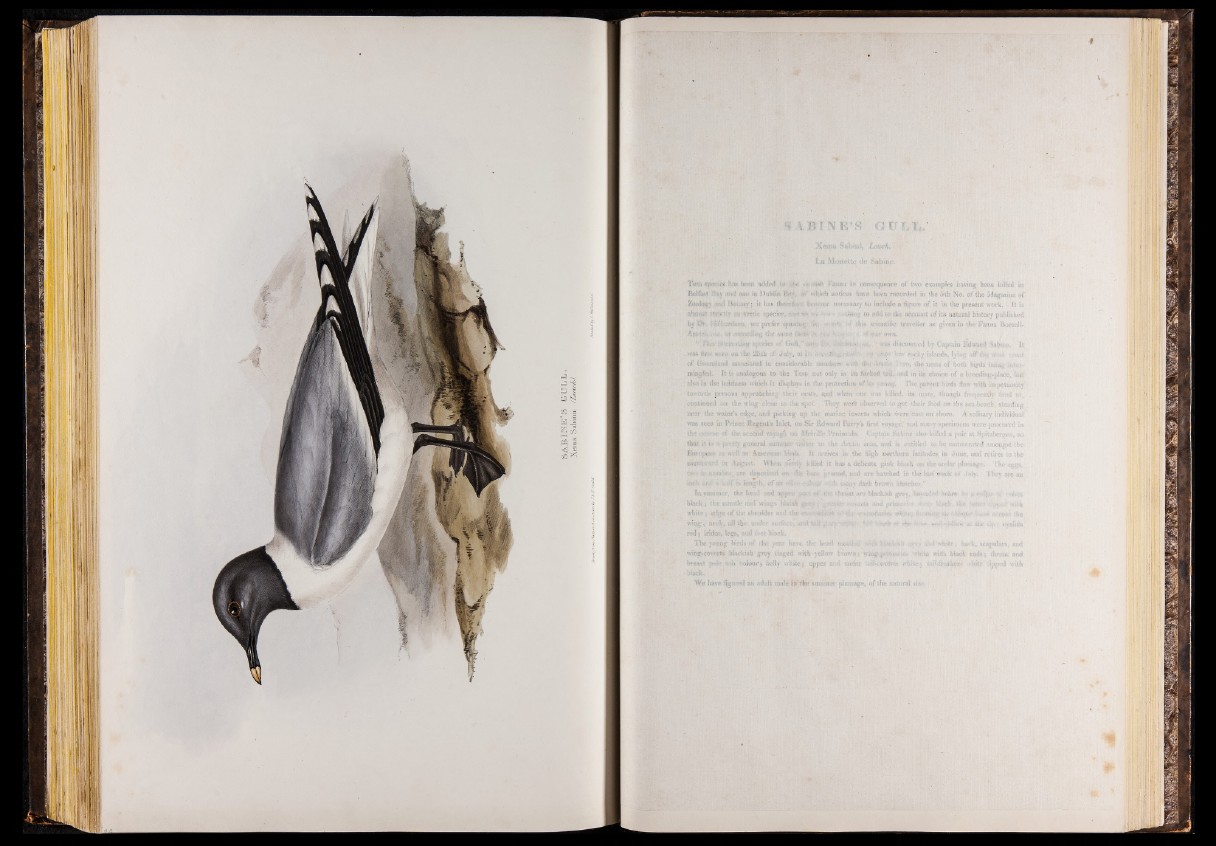
gifs
Xema Sabhrh, Leach. ■
La Mottette tie Sabine;
Tkffi «peraw te* been added is? «tei iy»*,sewh faBiwi inconsequence of two examples having' been killed in
jSetffei f|ay' awl one in DubHn EMy, d#iT which notices Have been recorded in tbe 5th No. o f the Magazine of
¡wwil. Iteiany 5 it has tttentjjbfi&:. taci i,-.r necessary to include, a figure of it in the present work; It is
stiijcliy ror.trade sped»,-wad-'«» -v* i - ■. thing to add to the account! o f its natural history published
by Ktyi {4fii*D»!}iiils«n>, we prefer - ** scientific' ttafefier as given in the Fauna Borealil
Awu*r«t .»'»a.. i|j; ¿’iM^irdintr the saute $sp$ ifpf tpflji' j • ffl ourr own,
" JvpCtficH of Gull, ’ I v ' was discovered, by Captain Edwairijl $abi®e.. It
wa* sir*’- ;*•<!«; 0» ibe 25.tb of July, at ¡¡U , «w mt'f-' low rocky islands, lying nit t ;u<; *M ■
of Grceiilafal associated in considerable nuttUtertt''wrlft kb« .ijii'ette ;■: mr, the nests ’of both birds, beiiig ¿nfci .
m-ingted. ft «> analogous to the Tera not only in its ibrked fciiip. mid in its choice of a breeding-plaee, but
also in die boldness which it displays in ’he protection of it* vsH>ng. Hie parent birds flew wife iraoeluosity
towards persons. approaching'-feeir nests, and whfflft''dlW-'%(isi''kilted, its mate, though
continued 011 the whig close lo the spot'. They were observed to get their food on tbe sea-beach, standing
near the water’s edge, and picking up tbe marine insects which were cast on shore. A solitary individual
was seen in Prince .Regents Inlet, on Sir Edward Parry's first voyage, -and. many specimens were procured in
of -tins second voystg« eft Meh’illc .iteuinswla. Captain Sabine also--killed a pair'at Spitsbergen, so
tbut is ft li, ¡jwwtijp general »uotete? tidier »0 the Arctic seas, and is entitled to be enumerated amongst the
.Ei*ri>pcBfl» es well .nr Amcrioau bird». ft arrives hi the high northern latitudes, in June, and mires- to the
S*wiljM(Wd in August. When /.wily killed it has a delicate pink bbiSfe, o« «fee under plOnia^e. Tim eggs..
arid are hatched in tbe last week ?i .liny. They are an
iiwih i(.4ki ik niijH’ i?v length, o f aa -»ife oteiiy dark brown, blotches.
In summer, the head and ujqw# »re blackish grey, bteMtdrd'heioKr !$$&£
black :} .fee Mantfe.and'wing? stttd pa&atefes* .«tetHp hy.«#.. she -kplfSf’;pi^cd'*fefe
white; edg^i of the shoulder and the •?'. fee .¡$-eov!d«w<«. witefei.Smdtegp-fitt aerd*« the
wing} neck, all the .a sfefece, •: I..: '•:•• *.-• ■• -• --»» titfMifpi eyelids '
red 5 i rides, legs, si;,4 foet black.
The young birds d jfe year have the M £ batik, scapulars, and
wing-coverfs blackish grey tinged with • yeilievr brown $ w 'ing>$nw&t vlnte with black end« ? throat and
breast pale ash co lo u r; belly white; upper and muter ia?l>covem while,; laihfijidlirip« tipped with
| black.
We have figured an adult ipale in the sutnmer plumage, of the natural six»'. .